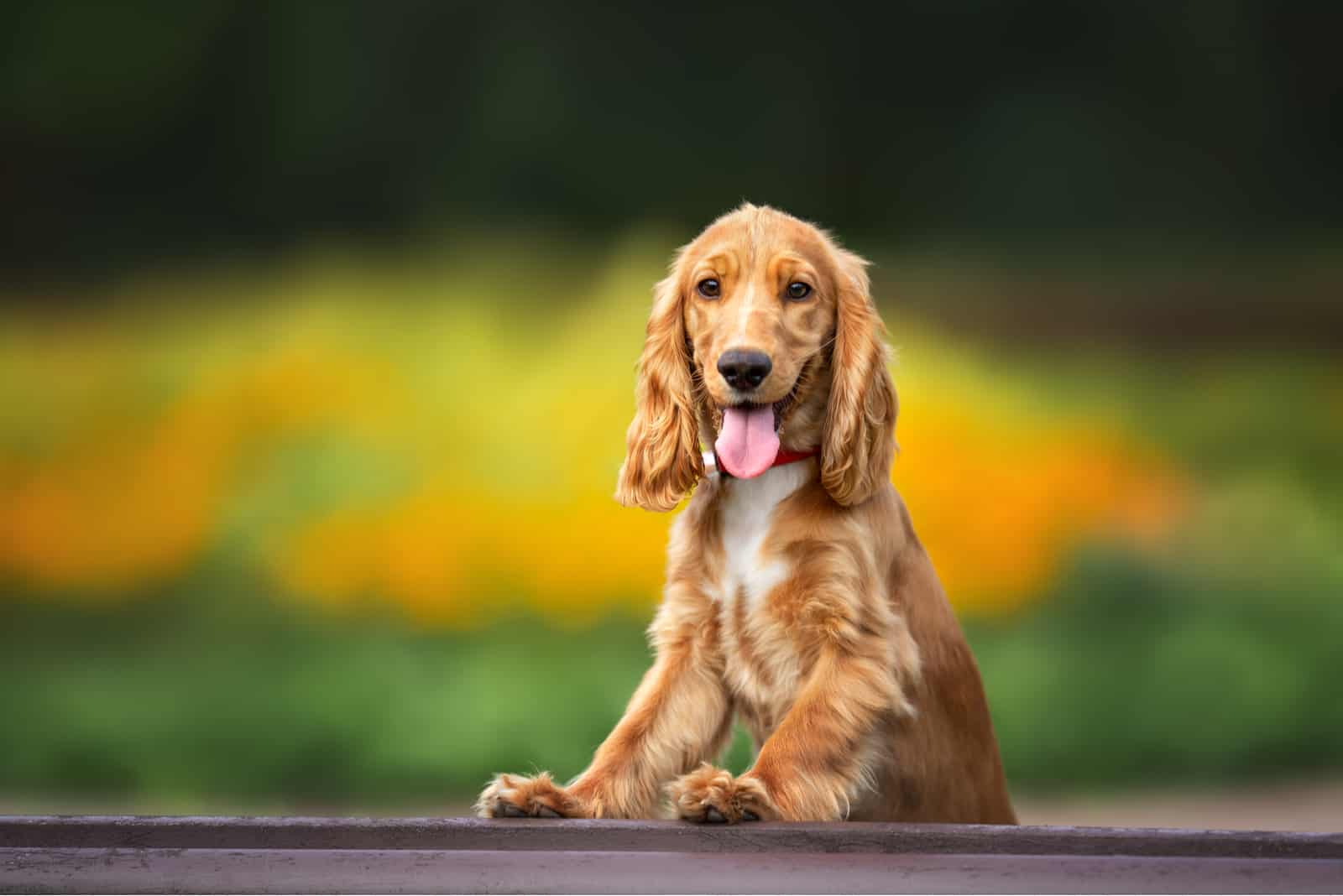If you want to know how many Cocker Spaniel colors there really are, you’ve come to the right place!
I have created a list of shades and patterns that will finally explain the difference between certain types of this sporting dog.
Cocker Spaniel clubs might not acknowledge all of the colors from the list as the standard shades of this breed, but that doesn’t mean they’re non-existent.
It’s finally time to present you with all of the beautiful shades that decorate the coat of these wonderful canines!
Cocker Spaniel Colors
1. Black
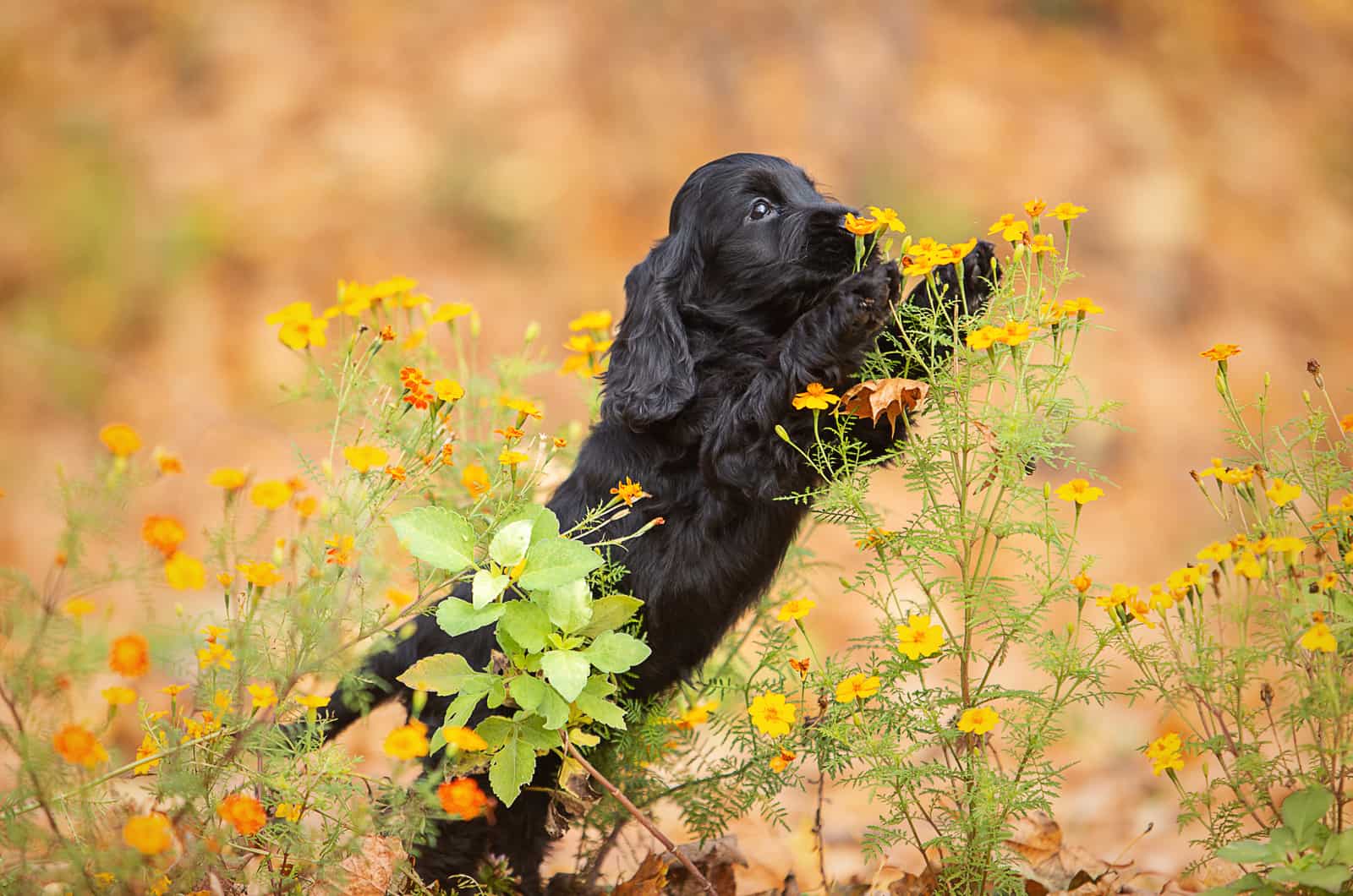
A solid black shade is one of the most common Cocker Spaniel colors that is acknowledged by the American Kennel Club (AKC).
According to the Cocker Spaniel breed standard, these pups should be completely black, including the nose and the area around the eyes.
However, small white markings might appear in the area below the mouth, which is acceptable for conformation events, although it’s not preferable.
The eye color of black Spaniel pups should also be of a deep brown or black hue; anything else is considered a fault by the AKC and other major canine organizations.
2. Red
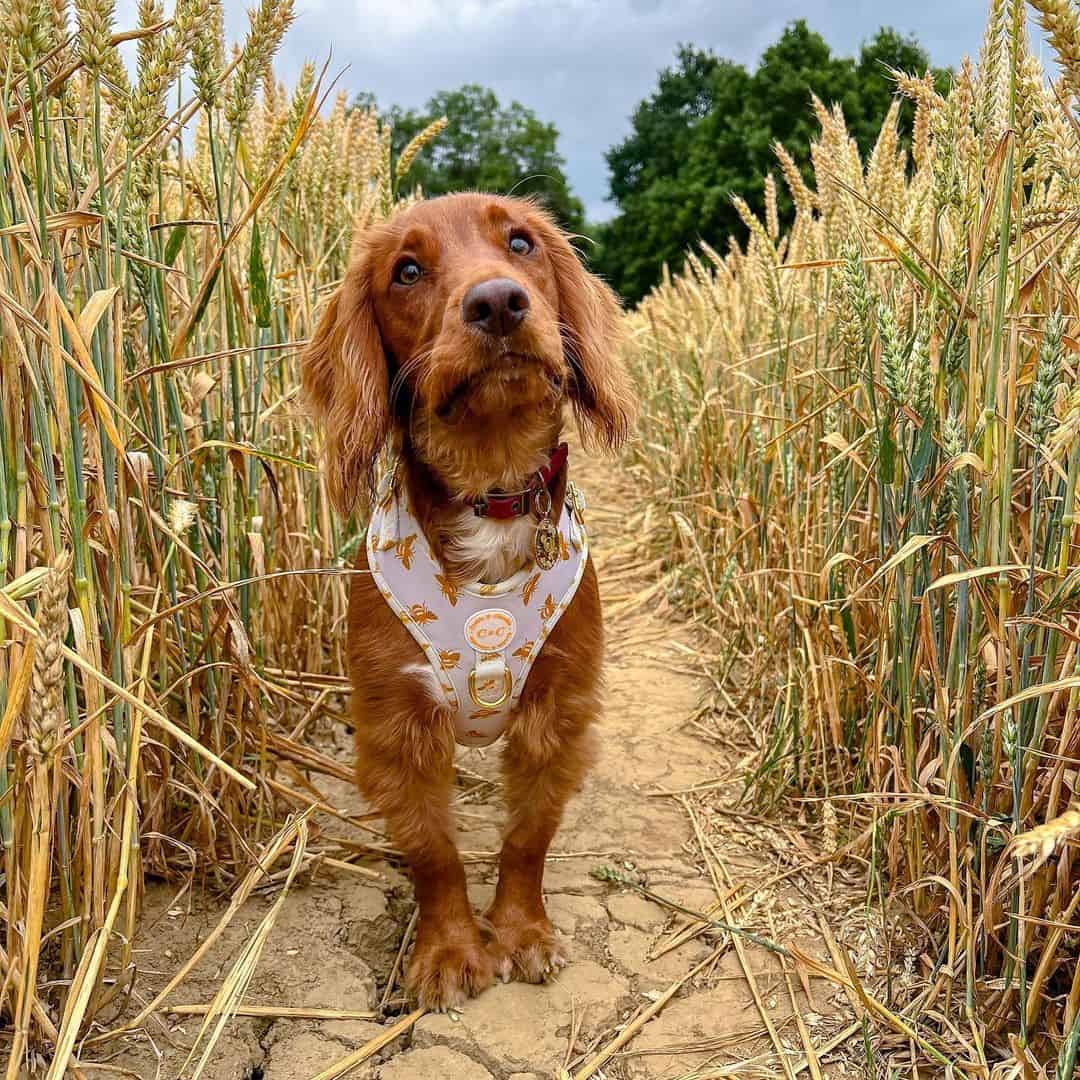
Photo from: @obiacespaniel
A solid red Cocker Spaniel has a deep color, which can be described as a combination of pecan and mahogany hues all in one.
Many people compare this shade to the Irish Setter’s recognizable red hue. These two breeds have a similar type of coat as well since they’re both long-haired, even though Cocker Spaniels have curlier coat hair.
RELATED: The 10 Best Irish Setter Breeders In The U.S. (2022)
When it comes to the nose color of red Cockers, they’re usually colored in brown or in liver hues. A black nose might appear as well, but in much rarer cases.
3. Golden
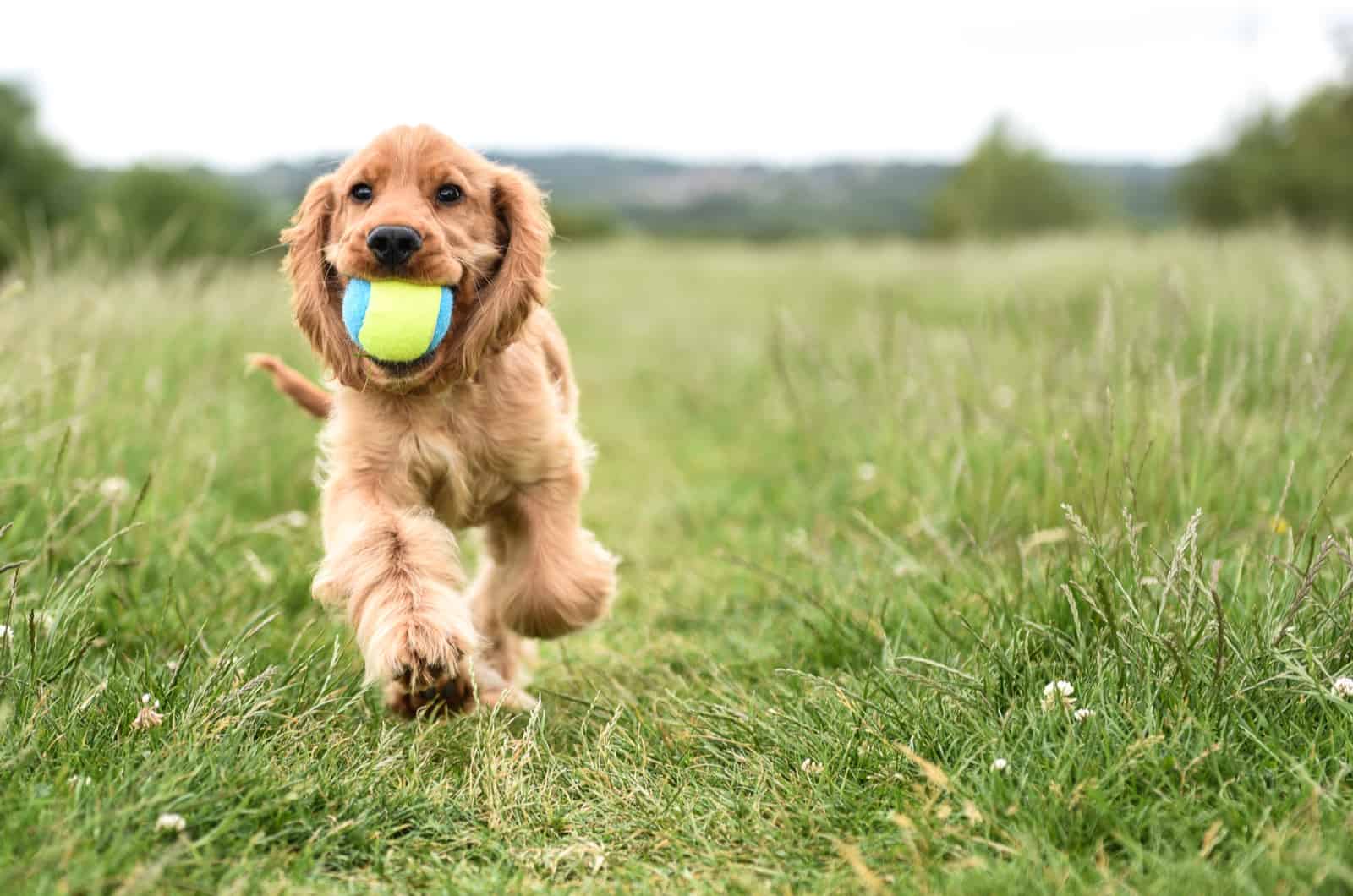
This type of shade was popularized by Golden Retrievers – adorable family pets whose soft coat and recognizable color remind us of a teddy bear (a big one, considering their size).
However, this “Golden Retriever shade” is quite common in many breeds, including the Cocker Spaniel.
The golden shade is sometimes called a caramel cream hue, which isn’t a surprise since they do look almost the same.
This color is best described as a darker type of tan or a lighter type of red Cocker Spaniel hues.
These pups usually have a black nose like the majority of doggies on this list. If they appear in a lighter shade, it’s more likely that the hue comes from dilution.
4. Liver
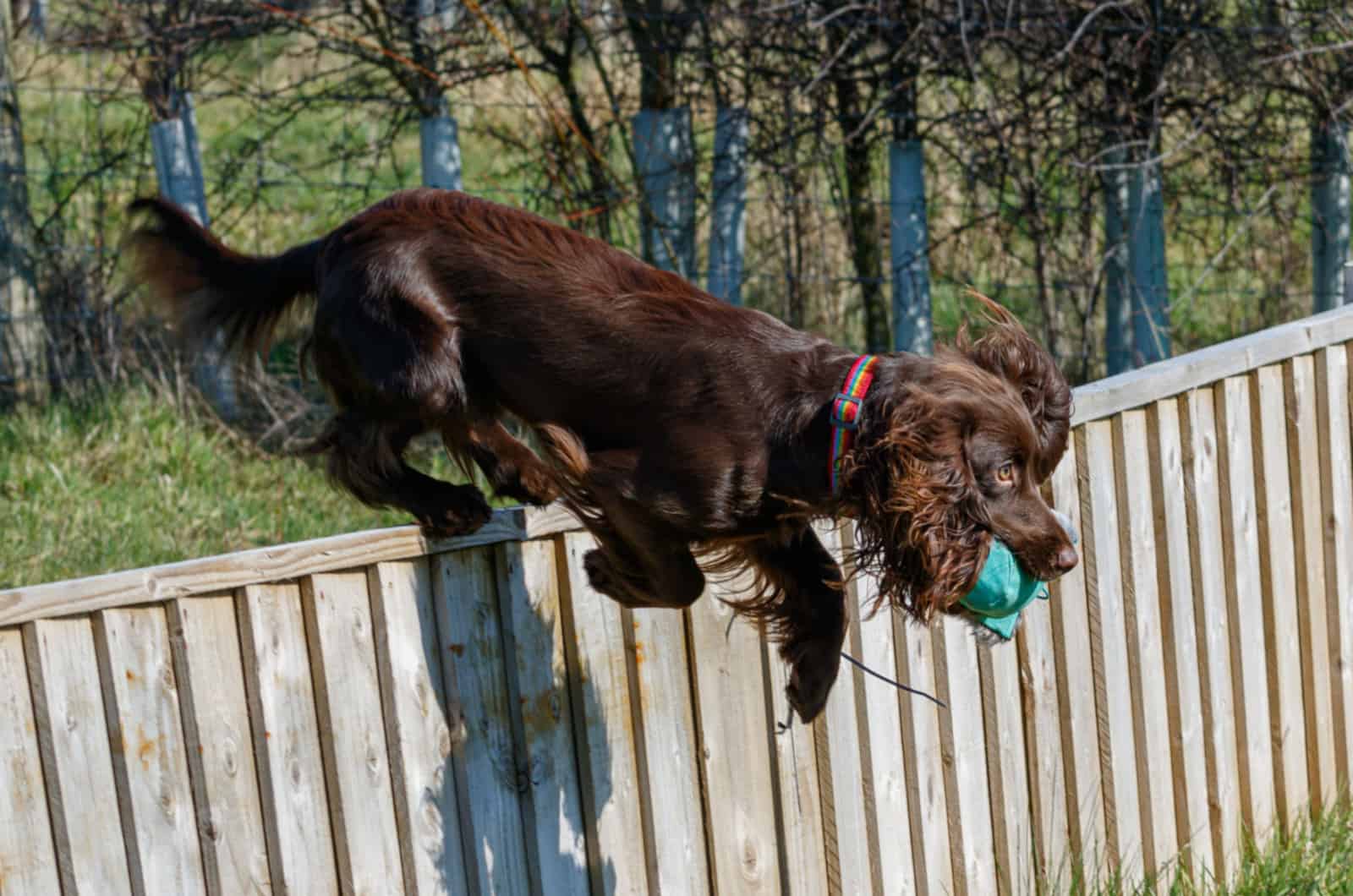
This shade is so similar to the chocolate hue that they’re often confused, although they’re not the same shade.
The main difference between liver and chocolate is the undertone of the coat shade as liver pups possess a hint of dark red tint, while chocolate pups have more of an earthy undertone.
Also, liver Cocker Spaniels will more often have a pinkish-brown nose than a black or a pure brown one.
This isn’t a common color of Cocker Spaniels, but it’s not impossible to find either.
This color usually appears in Cockers that are bred as working dogs; it’s signified by a white line that goes all the way from the neck to the tummy.
5. Parti
This is a type of Cocker Spaniel pattern that represents a combination of two or more different colors that usually appear in this dog breed.
Essentially, there are only six solid colors of Cocker Spaniels while all other shades are considered parti.
The majority of Cocker Spaniel puppies have markings of different shades on their coat, which are usually white lines that appear on the chest or tummy. If there aren’t any other markings on the coat, the white line is ignored and the pup is considered a solid-shade pup.
On the other hand, if there’s more than one line on the coat hair, this pup can be confirmed as a parti-canine.
6. Black And White
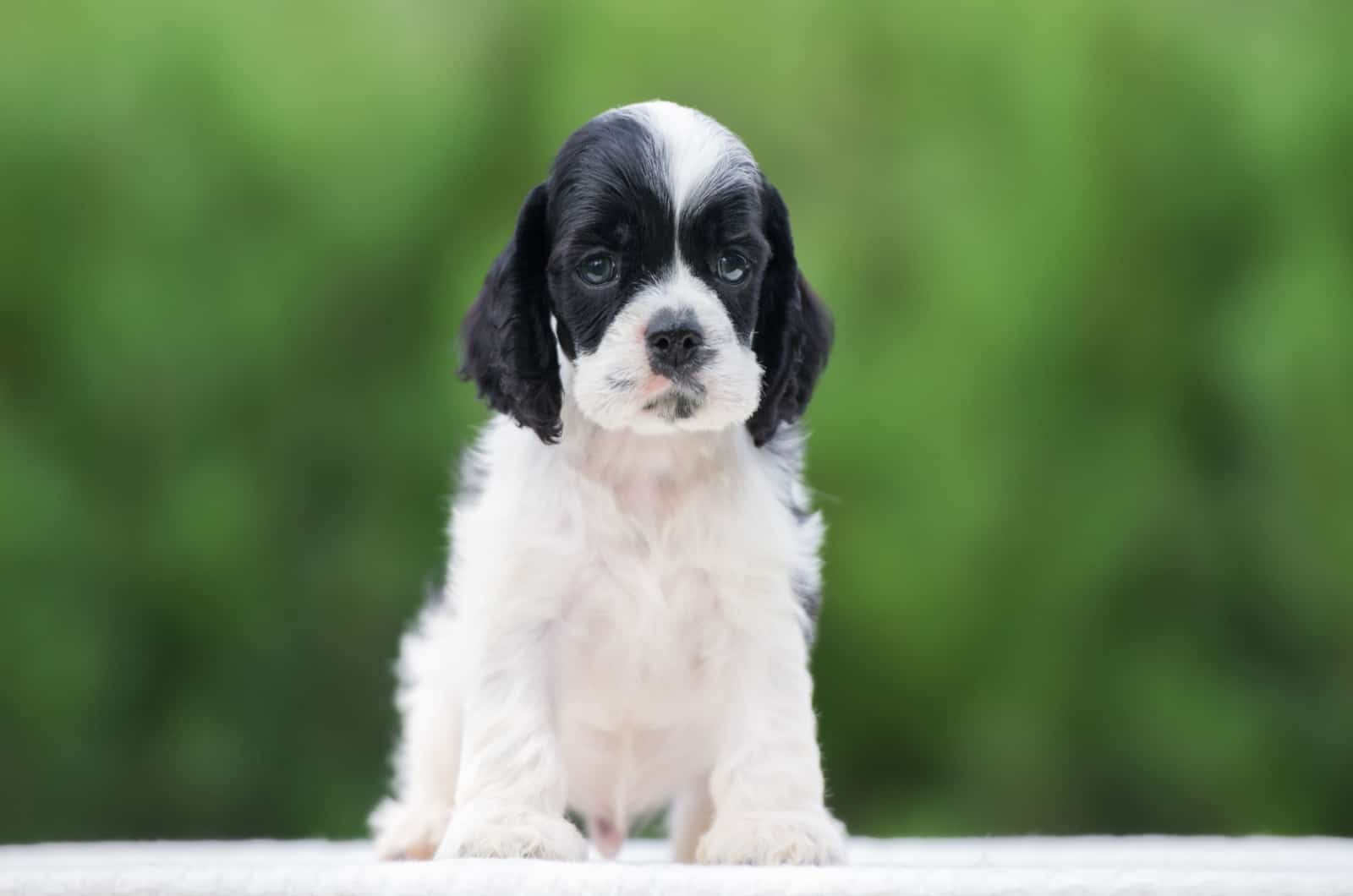
This is the first parti color on this list, and one of the most common types of the parti pattern amongCockerSpaniels.
The dominant shades of this combination are black and white, although a third hue might appear in some parts as well.
These pups are characterized by white parts that appear on the muzzle, and a line between the eyes that goes all the way up to the top of the head.
It’s interesting to notice that the primary shade of these pups seems to be white because it takes up most of the coat (chest, legs, stomach), while black appears in patches on the head and in the back, including the hindquarters that usually have both colors.
The black and white combination appears in other breeds as well, including Pitbulls, Border Collies, Shih Tzus, Huskies, French Bulldogs, and others.
7. Lemon And White
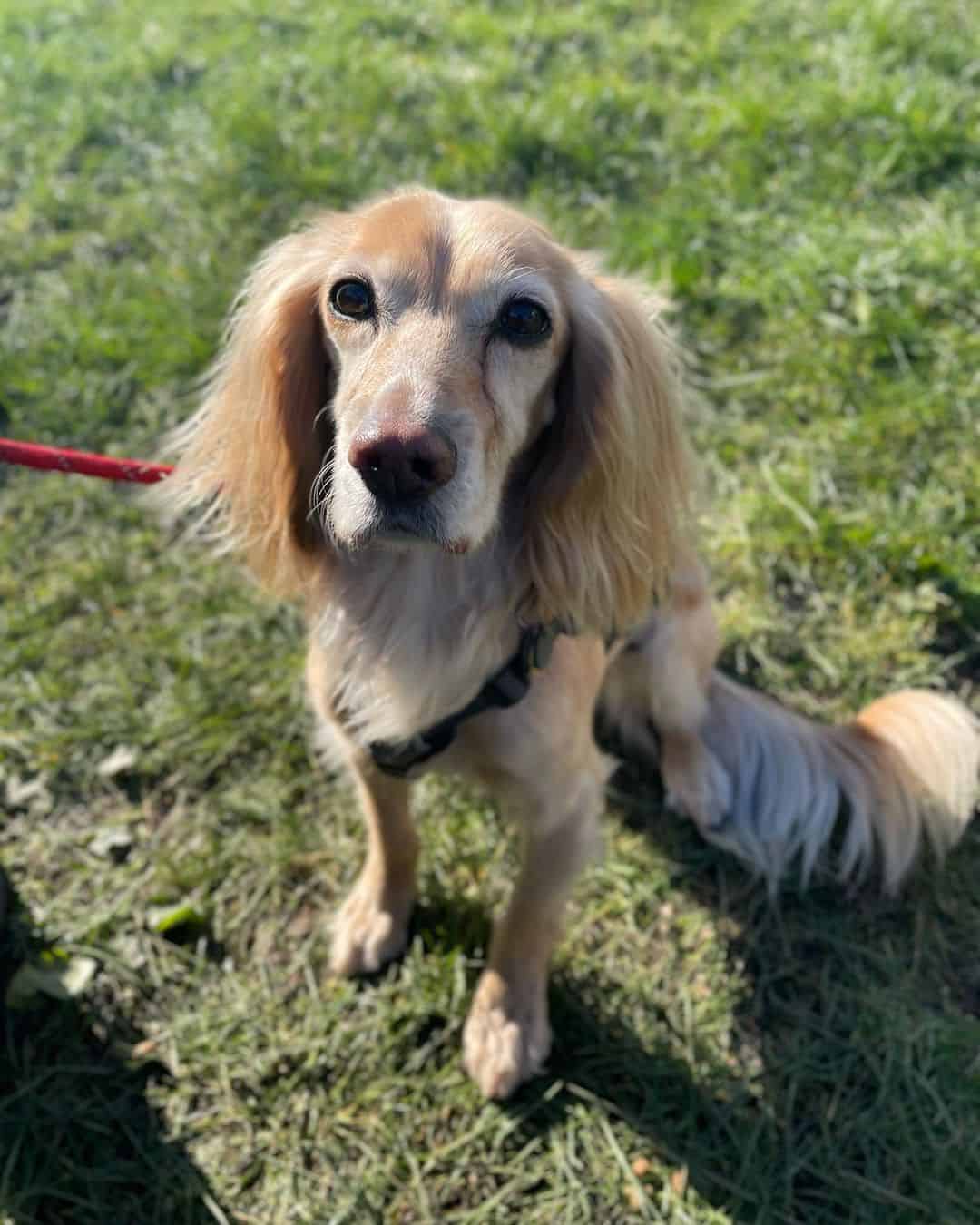
Photo from: @bellaboutthefells
This is one of the brightest shade combinations, which is characterized by light beige patches of color on a white coat.
This isn’t considered an official shade of Cocker Spaniels, but they do appear occasionally in Cocker litters.
These pups are quite rare, but they’re just as beautiful as all other shades on this list.
Some people might confuse the lemon shade of these doggies with golden or cream, but it’s rather between these two shades in the color spectrum.
8. Liver And White
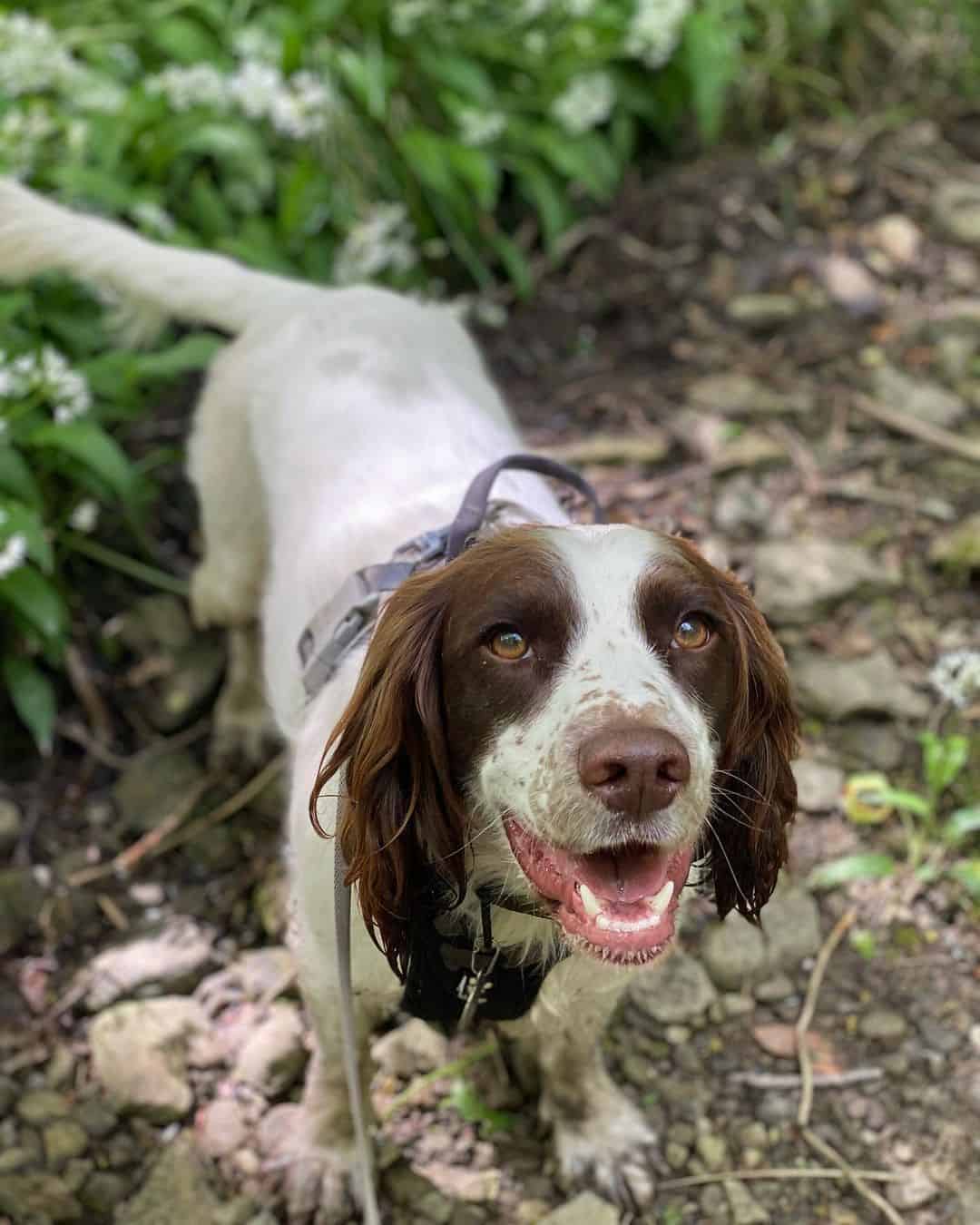
Photo from: @walkingwith
Just like the solid shade, the liver hue in liver and white Cockers is often mistaken for the chocolate color.
The liver and white hue combo appears in similarly patterned patches like the rest of the parti shade combinations, with liver as the dominant color on the head, and white on the rest of the body.
There can be certain patches and specks of liver color on the back.
The liver and white parti color is one of the shades that appear in English Cocker Spaniels, English Springer Spaniels, Sprocker Spaniels (American Cocker crossed with English Springer Spaniel), and others.
READ NEXT: English Cocker Spaniel Breeders: Top 8 Breeders In The States!
However, the patches in these breeds aren’t distributed in the same way as in Cocker Spaniels, which makes it easier to differentiate between them.
9. Red And White
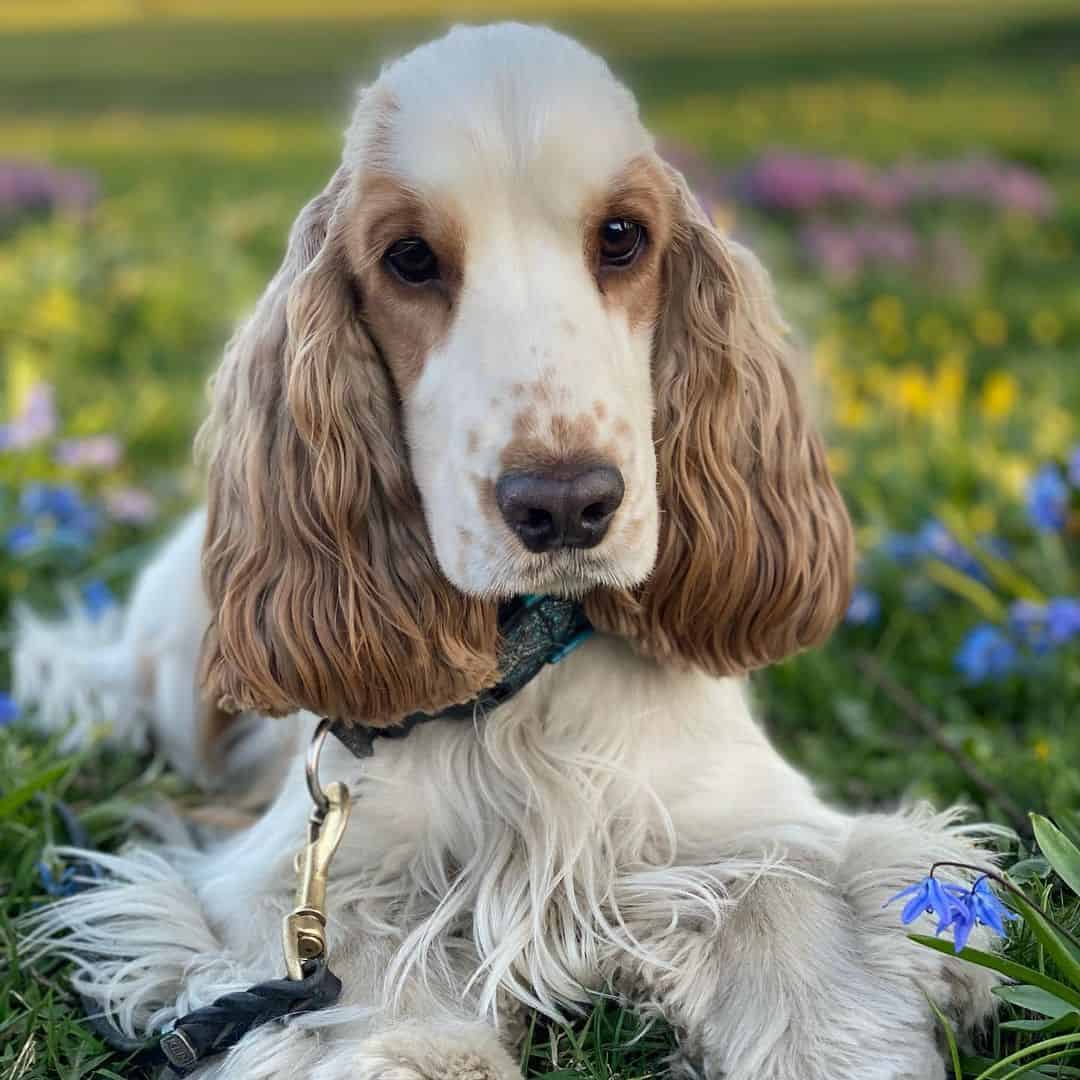
Photo from: @cocker_hebbe
Red and white Cocker Spaniel coats are often described as the deeper hue of the lemon and white shade, but some people might even confuse them because of their similar shades.
Red and white pups might not be suitable for conformation events because they’re not registered as an official hue, but they can still make adorable family pets.
This coat color is one of the rarest parti combinations, and it’s also an adorable one. The patches are usually distributed in the same or similar pattern, although they may differ slightly depending mostly on the type of Spaniel.
10. Orange And White
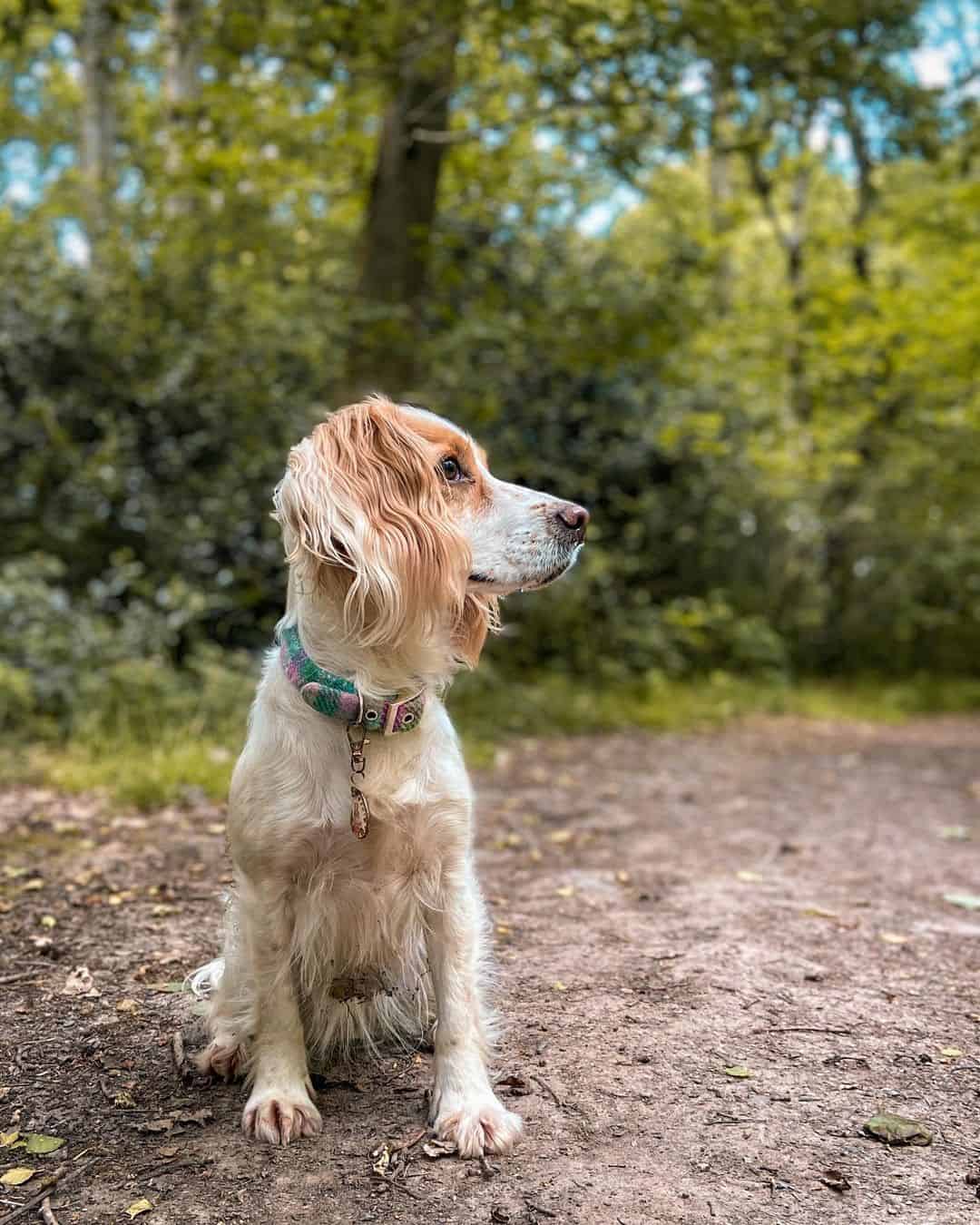
Photo from: @tiaandrosie_thespanners
Most people confuse the orange color for the lemon shade, which isn’t surprising, considering that these two hues look almost the same.
However, the lemon shade is usually brighter than orange, which might not be as easily noticeable until you compare the two.
The patches are usually found around the eyes and the muzzle, and on the ears, back, and sometimes paws, while the rest of the body is generally white (with a few specks of orange in some cases).
Roan Patterned Cocker Spaniels
Dogs with roan patterns on their coat have a few white hairs on their body scattered here and there.
The light white hairs on their body might sometimes give the impression that their coat is lighter and brighter than it actually is.
This particular Cocker Spaniel pattern has white hairs that are typically intertwined with its colorful hairs, giving it a distinguishing appearance most of the time.
Sometimes, there can be confusion between certain patterns and shades; therefore, it’s time to finally put an end to the misconceptions in the next few paragraphs!
1. Orange Roan
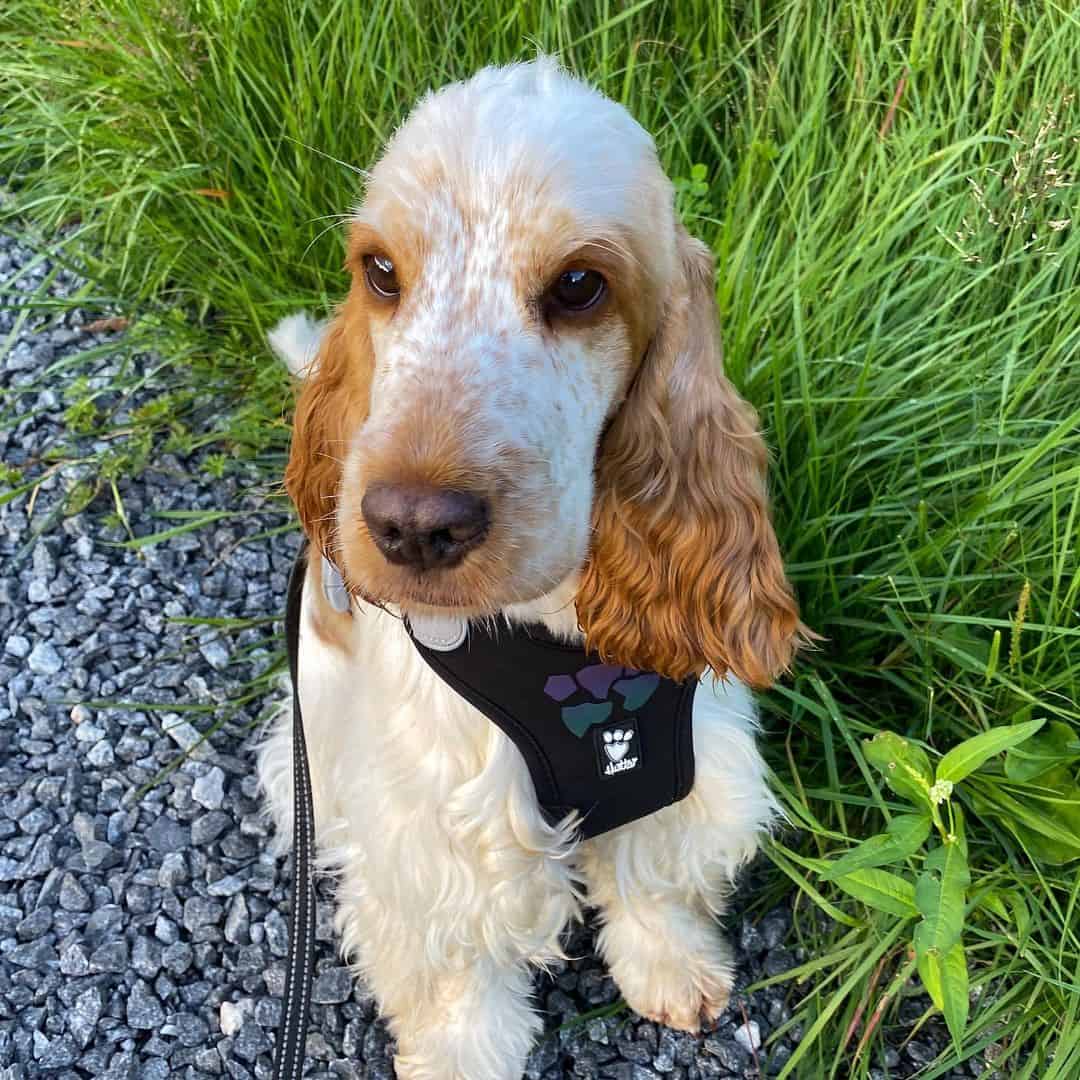
Photo from: @maisacockerspaniel
Some people might compare the orange roan Cocker with the orange and white parti pups, and they wouldn’t be completely wrong as these two do share quite similar patterns.
However, the main difference between these two types of Cocker coats is the amount of orange that is positioned on the white coat.
Orange is more dominant in the roan pattern as it appears in both patches and additional specks all over the body.
2. Blue Roan
The blue roan Cocker Spaniel is typically considered to have a blue shade on its coat, although this really isn’t the case.
It may sound confusing at first, but the color ‘blue’ does not appear on the blue roan’s coat at all.
Actually, the blue roan shade stands for a black-coated Cocker puppy that is speckled with white hair all over its body.
This combination of hues creates a beautiful and unique shade that looks more like dark, smokey-blue color.
3. Chocolate Roan
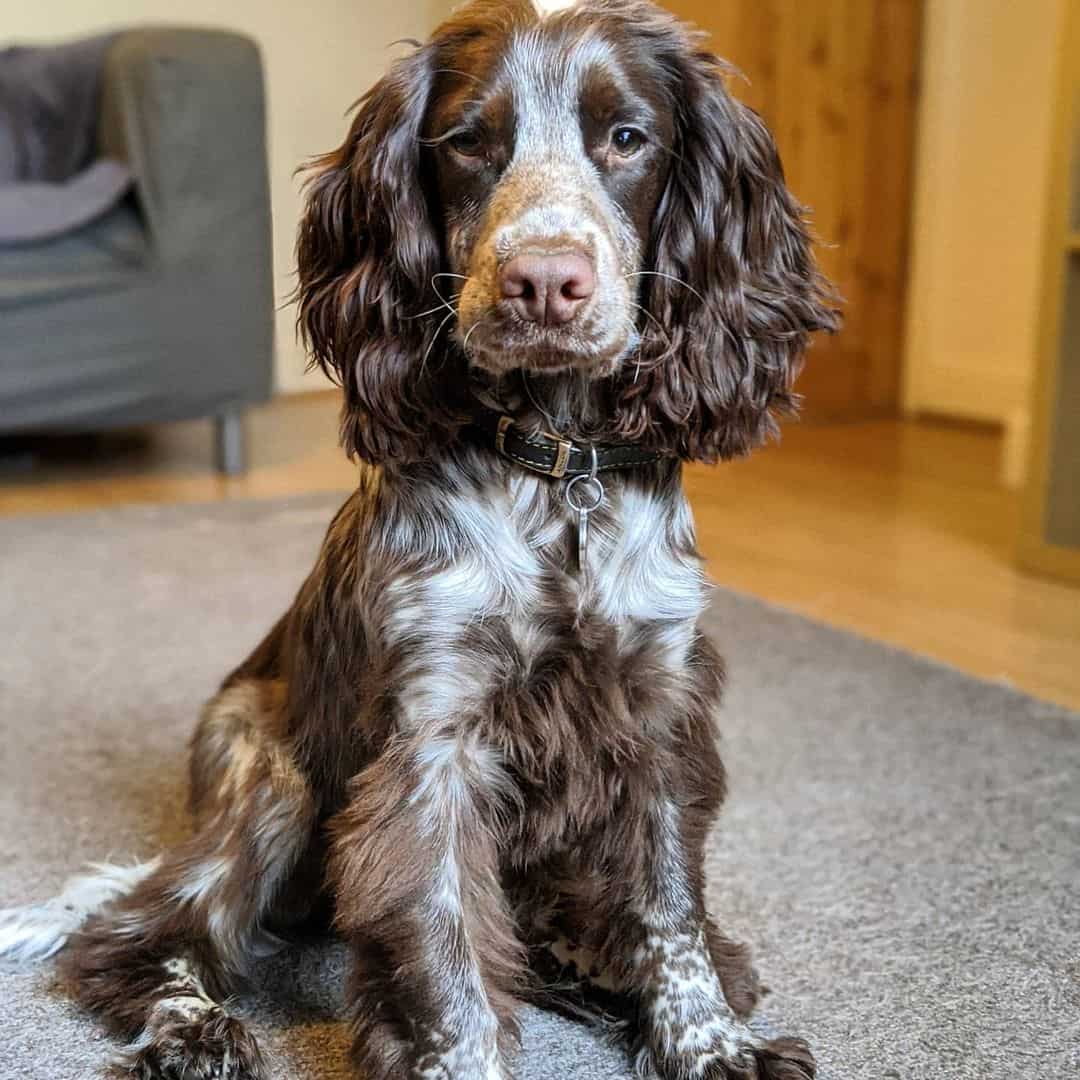
Photo from: @chocolateroan.henry
This type of Cocker Spaniel has markings similar to the parti pattern, but the chocolate/brown shade is more dominant on the white background than the parti shade.
Along with chocolate patches, the roan puppy also has additional spots on its entire body, which makes the white color look more like a light chocolate shade than pure white.
This color looks even more beautiful on long-haired Cocker Spaniels!
4. Lemon Roan
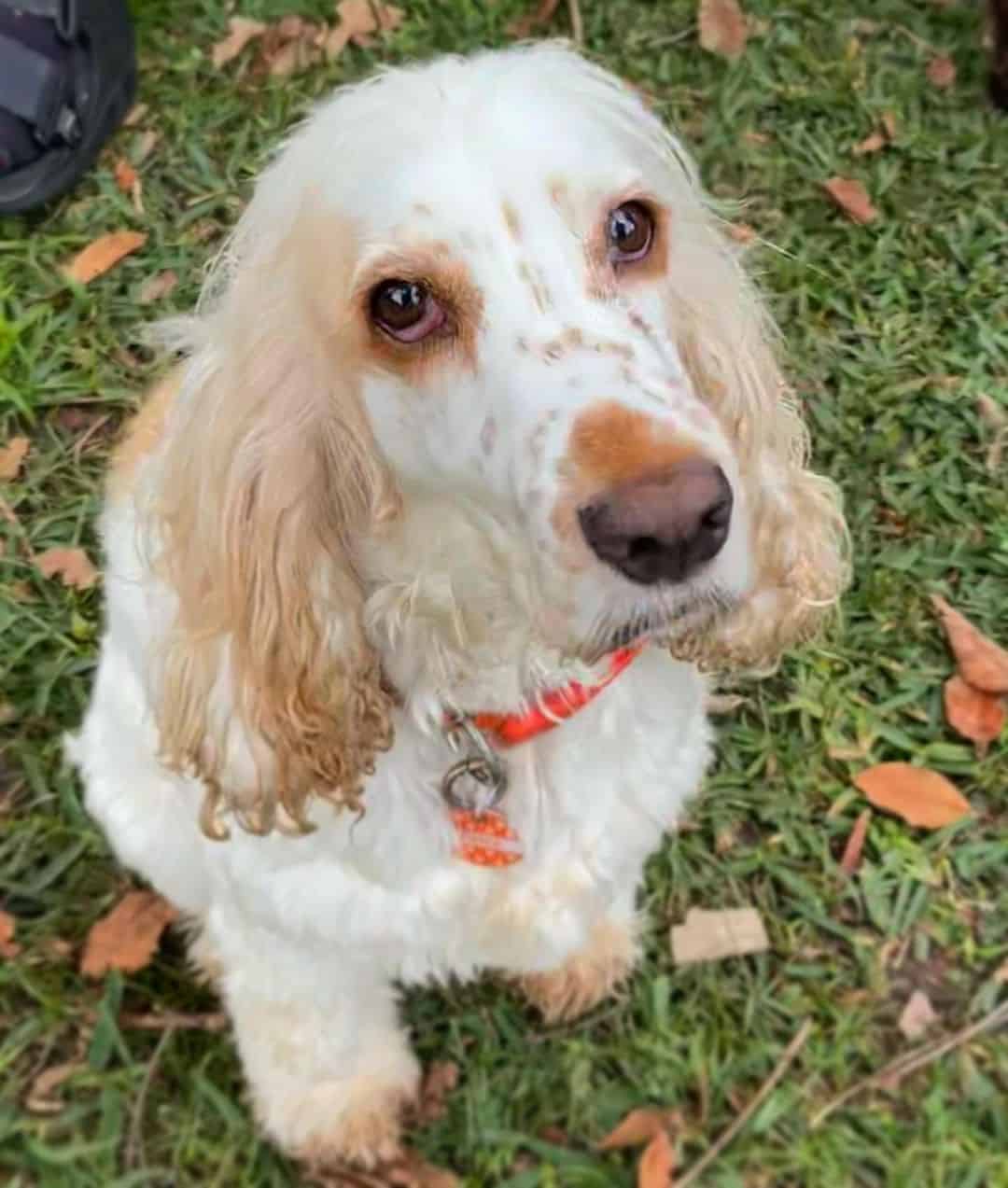
Photo from: @millee_daisy_gorgeous.spaniels
This type of color is generally considered a shade that possesses a black or a bright brown pigment that is further diluted into a tan-like shade with a white background.
Several parts of the body contain the lemon shade, which reminds us of a light cream/caramel hue.
However, the lemon shade is also interspersed throughout the coat in little dots, which is also the basic difference between a lemon roan and parti shades.
5. Red Roan
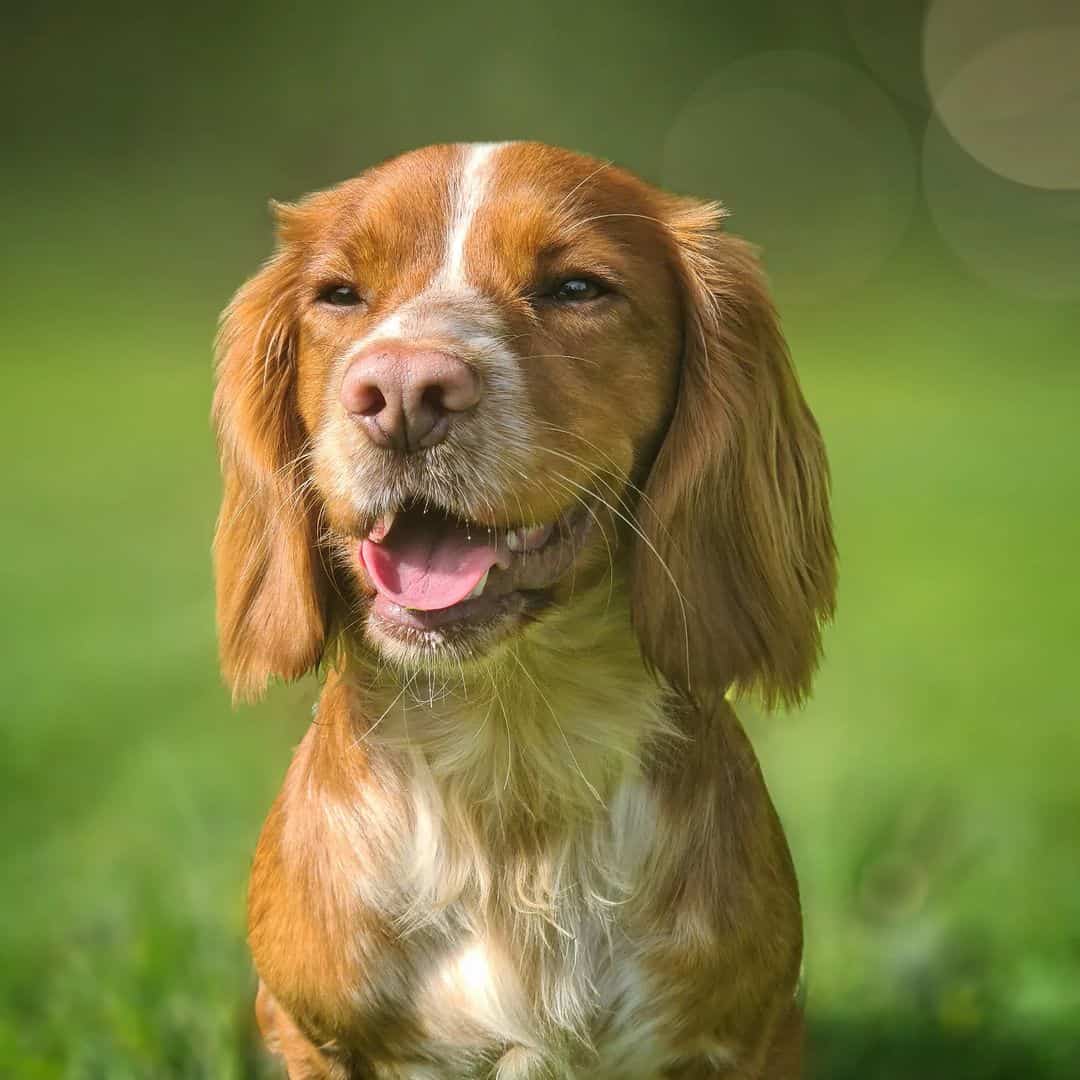
Photo from: @nhu_ecology_dogs
The red roan shade would best be described as a pattern that is somewhere between the solid red and the parti red and white shades.
Essentially, this type of red pattern shares similar blotches of red color on the primary color (white), but it also includes red dots in other parts of the coat.
Tan Combinations
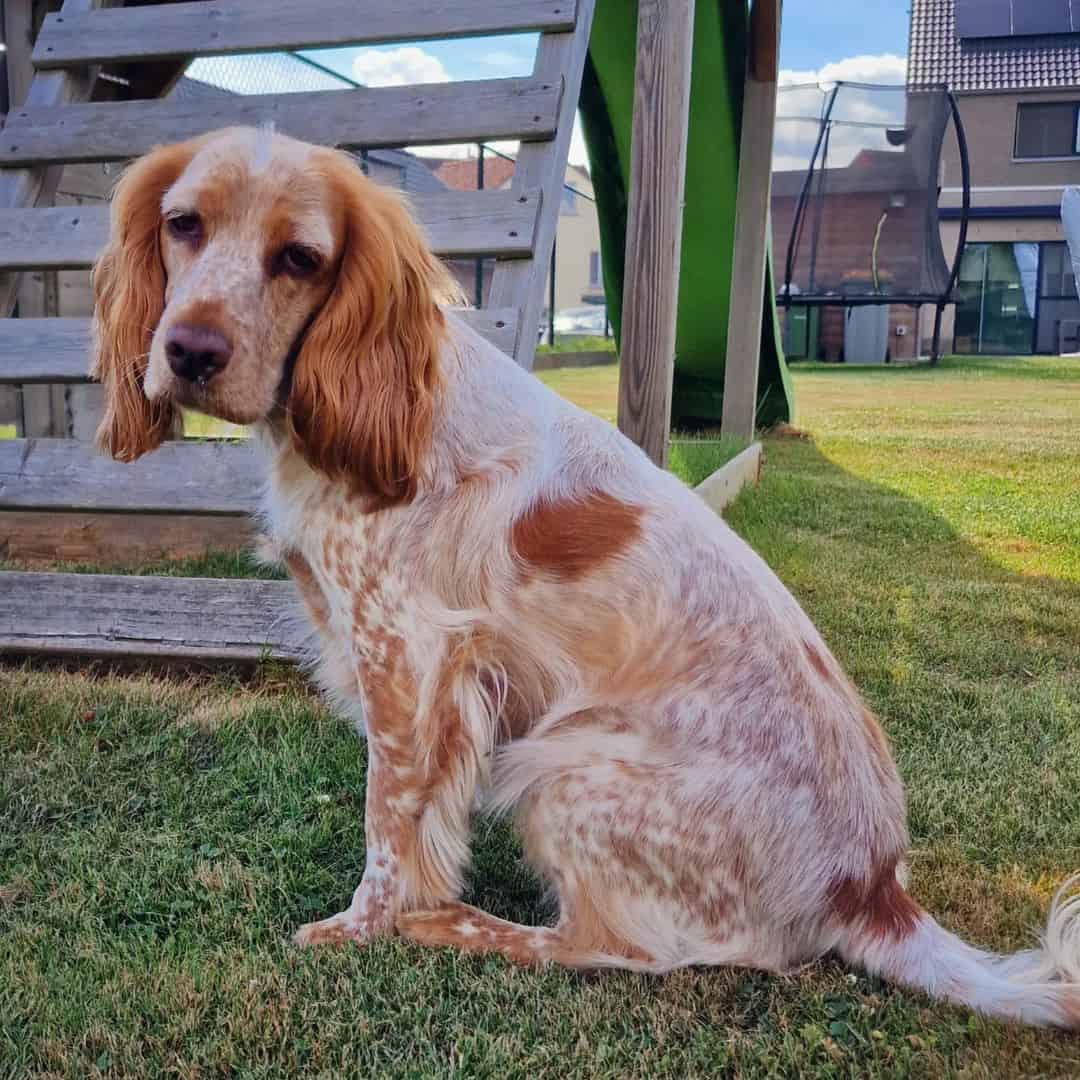
Photo from: @nala.cute_cockerspaniel
According to the breed criteria established by the AKC, points can only be awarded for the following places:
• Tan dots above the eyes
• Around the muzzle
• On the back of the head and behind the ears
• On the legs and paws
• On the back
• On the chest
• Under the chin
1. Black And Tan
These beautiful pups have a shiny, black coat with tan markings in particular places throughout their coat hair.
Tan points can vary from a light beige hue all the way up to reddish color, and their coverage on the body should be limited to 10 percent or less.
The same goes for the black and tan Cocker pups that share the same shade combination as Dobermans, Rottweilers, Dachshunds, and other dog breeds.
Therefore, it should be no surprise that some people think of black and tan Cockers as crosses of the canines mentioned in the paragraph above.
2. Blue Roan And Tan
Essentially, this type of coat is best explained as a blue roan Cocker Spaniel with tan patches that appear in specific parts of the Cocker Spaniel’s body.
Some people might confuse this mix of colors with the tri-colored black, white, and tan Cockers mostly because their coat contains the same shades.
However, the black and white in the roan variation mostly blend into a type of blueish-gray shade, which is why it’s called blue roan.
Still, the tan markings are clearly visible and cannot be mistaken for any other color.
3. Liver Roan And Tan
The liver shade might be named chocolate in some parts of the world, although there’s a slight difference between them that we spoke of before.
The liver roan and tan are combined in a similar way as the blue roan and tan by having two colors (liver and white) already blended into a beautiful spectrum of brown shades, from dark chocolate to a pale grayish-brown hue.
These pups have amazing qualities just like any other Cocker Spaniel, and also a unique appearance that will turn heads for sure.
4. Liver And Tan
If you thought that the pups above look cute with their beautifully-colored coat, check out this type of shade that looks like the most delicious milk chocolate in the world!
The beautiful hues that range from tan, orange, and liver, to dark chocolate are all found on the coat of liver and tan Cocker Spaniels.
The feathering hair on their ears looks luxurious in this shade, while the rest of their body seems like it’s covered with the softest fur, although it’s more of a wiry feel.
5. Liver, White, And Tan
If you take a bicolor puppy that is covered in liver and white shades and add a little bit of tan in certain spots, you’ll get the perfect and unique-looking pup.
This tricolor tan mix doesn’t appear quite often. However, this combination of colors makes them look like real gundogs, which isn’t surprising as both English Cocker Spaniels and American Cocker Spaniels belong to this category of canine breeds.
6. Black, White, And Tan
Cocker Spaniels that are black, white, and tan are also regarded to be of the parti-color kind, but with the addition of the third shade above the eyes, around the muzzle, and in other places throughout the body.
Tan points are basically the only way to distinguish these doggies from black and white Cocker Spaniels, which they resemble otherwise.
The tan spots are usually positioned in the same way as tan markings on all other tan combinations.
Sable-Patterned Cocker Spaniels

Photo from: @ruperttheshowcocker
There is a wide range of coloration among sables, which includes chocolate, silver, black, and golden Cockers.
There aren’t many variations when it comes to the sable pattern mostly because it already has multiple hues on one part of the body, with the possible additions of white and tan shades.
1. Sable
Sable is listed as one of the Cocker Spaniel colors within the AKC’s breed standard for this canine, although they don’t go into details recognizing the different shades that appear within the sable pattern.
The hues that go under the sable category are chocolate, red, black, and clear sables.
There will always be dark hairs (either black, chocolate, or red depending on the color of their coat) running throughout the sable’s fur.
If you want to know whether your puppy will be sable, examine their eyes as well as their fur in order to determine whether or not they will be sable as they grow up.
This is especially important if you are searching for a sable puppy exclusively.
2. Sable And White
Essentially, the description of a sable Cocker Spaniel, in general, will suit the definition of a sable and white Cocker pup.
Even though this pattern already contains different colors, the sable and white canine will have distinctive sable markings all over its body while white serves as the base hue.
It’s understandable that it’s difficult to find differences between all these Spaniel dogs that look very similar because of the same shade combinations, but it’s all in the details.
The markings are usually found in different places, sizes, and spectrums, which is how you’ll be able to differentiate between all of them – all it takes is just a little bit of patience.
3. Sable And Tan
This is the same as for sable and white – the general definition of a sable Cocker is the best explanation for this pattern as well.
However, this time, instead of white, the coat will consist of sable patches and a tanned background.
If this type of coat looks familiar to you, it’s because the sable and tan Cocker Spaniels share the same colors as German Shepherds and French Bulldogs.
Other Patterns Of Cocker Spaniels
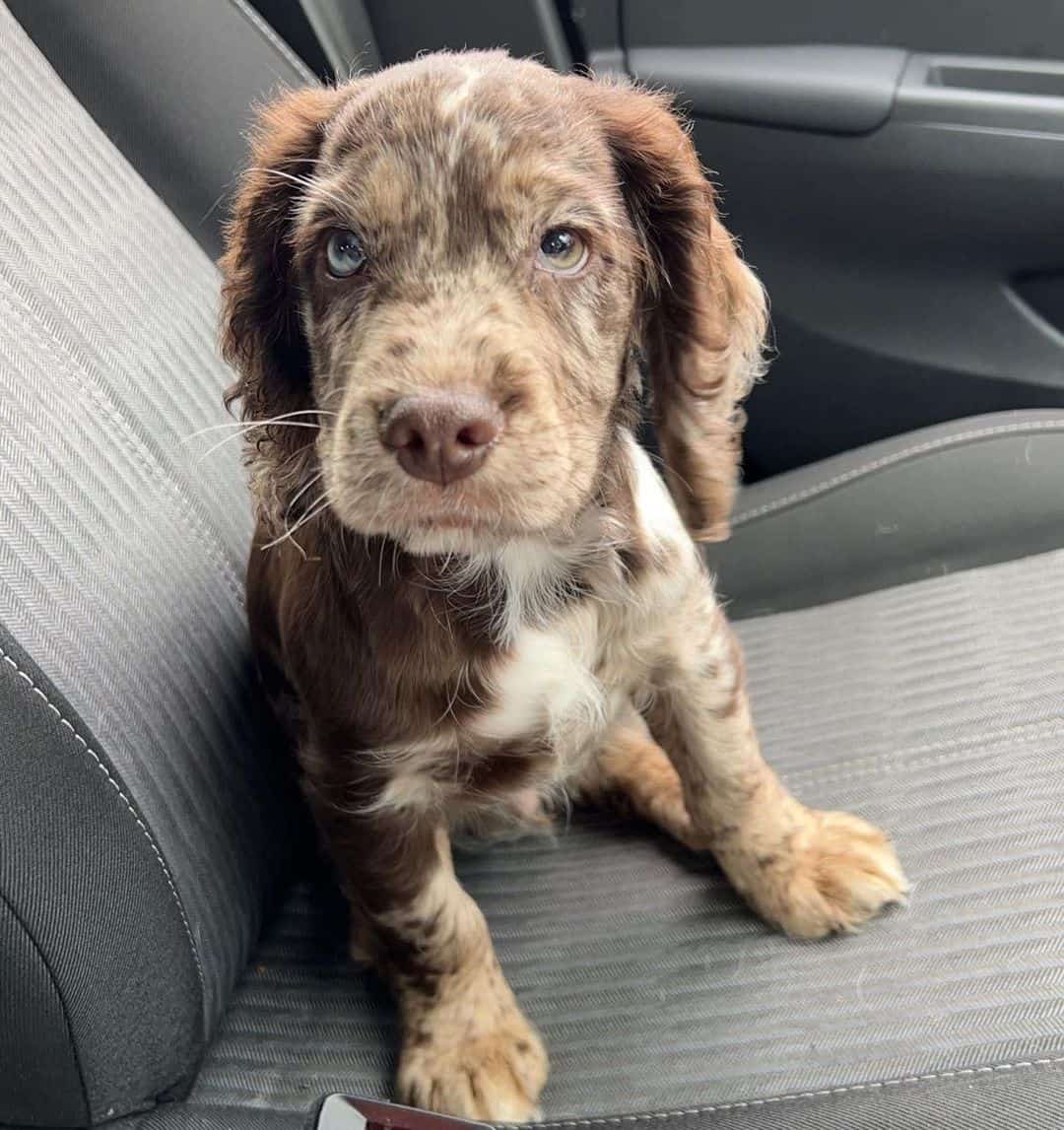
Photo from: @top.dogzz
There are a few Cocker Spaniel colors and patterns that might not fit any of the categories mentioned above, which is why they deserve to have a category of their own.
Here are the three other ways to classify the colors of these adorable puppies!
1. Merle
This pattern is believed to be a result of the mutant color gene that carries this pattern and causes a change in coloration of the Cocker’s eyes and fur.
Although it is not feasible to demonstrate this in a laboratory setting, there is a school of thought that maintains that the merle gene was brought in from another breed.
This is one of the reasons why merle isn’t accepted as an official shade. Another reason would be the fear of crossing two merle pups, which would end in a double merle canine that would be prone to severe health issues.
2. Ticking Pattern
This type of pattern is common in roan shades. Remember those small flecks I mentioned? They’re known as a ticking pattern.
This is exactly what differentiates roan colors from the bi- and tri-color combinations as they all share the same shades.
In some cases, there might be fewer patches and more spots of colors, which technically doesn’t make them roan, but ticked Spaniels.
3. Open-Marked Pattern
This is quite the opposite of the pattern that is mentioned above.
If roans are distinctive because of the little specks of colors on all parts of their body, the bi-color and tri-color are recognized because of the open-marked design that combines one or two shades with a pure white base hue.
What Is The Most Common Cocker Spaniel Color?
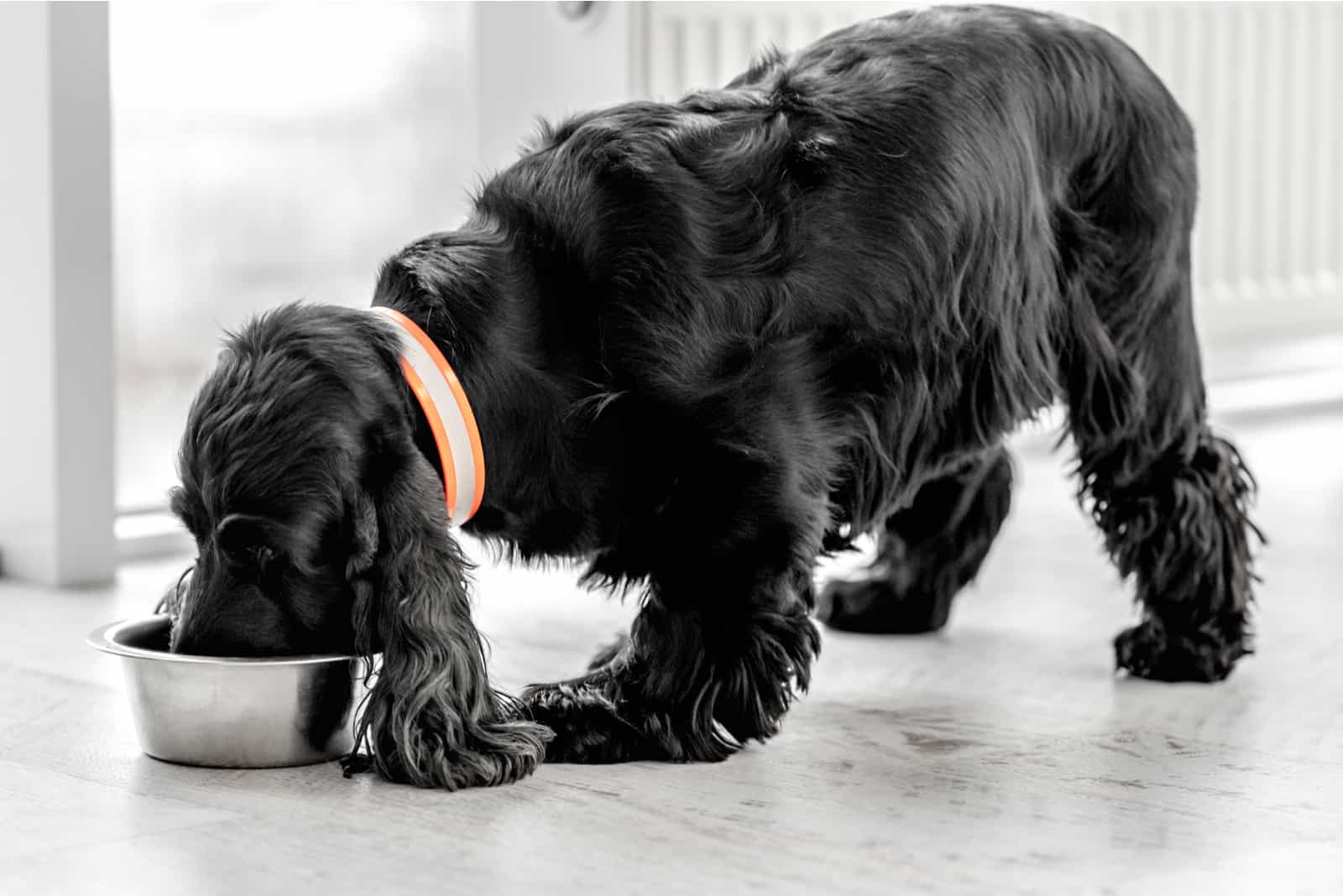
The Black Cocker Spaniel seems to be the most popular canine that can be seen quite often among Cocker Spaniel lovers.
Black is generally a common shade in many breeds of dogs, so it doesn’t surprise us that it’s popular as a Cocker Spaniel shade as well.
Multiple-color combinations are generally rarer than solid shades, which is why they might not be as popular, even though they’re also beautiful.
Are Cocker Spaniel Coat Colors Connected To Health Problems?
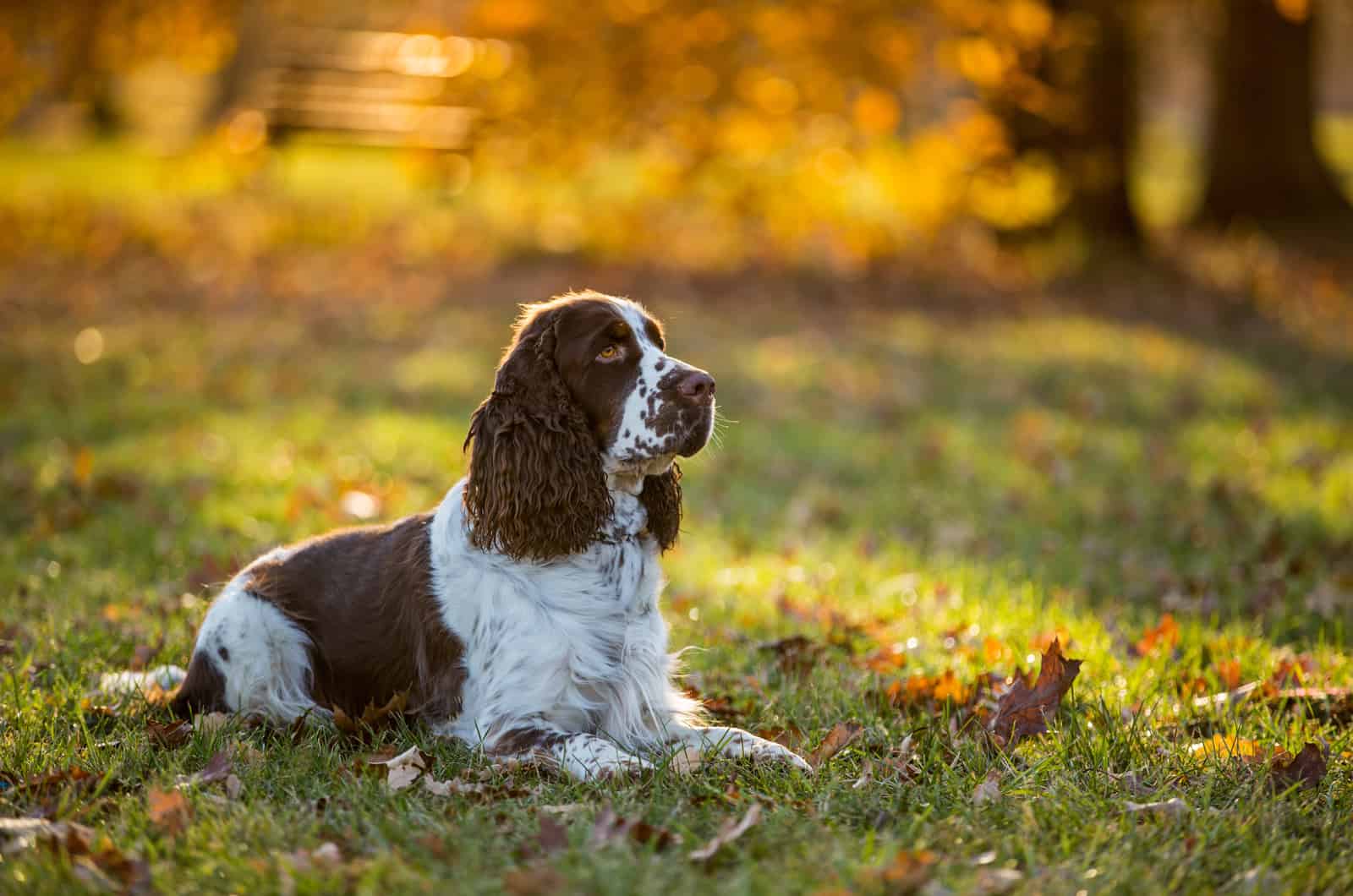
The coat hair type and shades are generally entirely related only to the physical appearance of every purebred canine.
Therefore, the shades and patterns shouldn’t have any negative impact on the health of these hunting dogs. Still, there’s an exception to every rule, including this one.
White Cocker Spaniels
Even though they appear on extremely rare occasions, white (albino) Cocker Spaniels might pop up.
Unfortunately, the white shade of their coat and the pinkish hue of their nose are the result of the lack of color genes, which reveals other issues, including health conditions such as deafness or eye issues that might cause blindness.
Are Health Issues Related To The Type Of Coat?
Shades might not generally have an impact on a pup’s health, but a long-haired coat might, and not only for your pup, but for you as well as they’re not a hypoallergenic breed.
This dog breed is known for its long, floppy ears that have long hair over them. Even though they look really cute with such ears, it’s not cute when it comes to their health.
Unfortunately, Cockers are prone to severe ear infections (mostly bacterial) because of the moisture that is preserved if the hair isn’t dried well enough.
Also, the hair around the eyes can cause eye infections, which could lead to sight impairment.
It’s also important to mention that these pups might develop cataracts – an eye condition that could also cause serious damage to their eyesight.
Wrapping Up
If you’re surprised by the number of Cocker Spaniel colors, I don’t blame you as this popular breed usually appears in shades like black, golden, black and tan, etc.
However, now you know that there are other breeds than an Aussie Shepherd sporting the tricolor hair pattern.
RELATED: The Red Tri Australian Shepherd: Here’s What You Need To Know
Although shade shouldn’t be the main reason as to why you’re getting a certain puppy, it’s understandable that there are people who are looking for more unique variations of Cocker Spaniels, and they want to know more about the spectrum of their coat colors.
I’m sure each of the English Cocker Spaniel puppies you choose will become the perfect pet regardless of their coat hue!
READ NEXT:
Male Vs. Female Cocker Spaniel: The Sweetest Dilemma Ever
Do Cocker Spaniels Bark A Lot? Here’s The Honest Answer!
